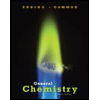A student used a piece of aluminum that had a mass of 2.583 grams, and treated according to the same procedure you used in this experiment.2 Al(s) + 2 KOH(aq) + 4 H2SO4(aq) + 22 H2O(l) → 2 KAl(SO4)2•12H2O(s) + 3 H2(g) What is the mass of Alum theoretically possible? (Hint – Use the molar mass of the alum calculated in question #1.)
A student used a piece of aluminum that had a mass of 2.583 grams, and treated according to the same procedure you used in this experiment.2 Al(s) + 2 KOH(aq) + 4 H2SO4(aq) + 22 H2O(l) → 2 KAl(SO4)2•12H2O(s) + 3 H2(g) What is the mass of Alum theoretically possible? (Hint – Use the molar mass of the alum calculated in question #1.)
Chemistry & Chemical Reactivity
10th Edition
ISBN:9781337399074
Author:John C. Kotz, Paul M. Treichel, John Townsend, David Treichel
Publisher:John C. Kotz, Paul M. Treichel, John Townsend, David Treichel
Chapter25: Nuclear Chemistry
Section25.8: Applications Of Nuclear Chemistry
Problem 1.4ACP: Calculate the molar mass (atomic weight) of naturally occurring uranium from the masses of the two...
Related questions
Question
A student used a piece of aluminum that had a mass of 2.583 grams, and treated according to the same procedure you used in this experiment.
2 Al(s) + 2 KOH(aq) + 4 H2SO4(aq) + 22 H2O(l) → 2 KAl(SO4)2•12H2O(s) + 3 H2(g)
What is the mass of Alum theoretically possible? (Hint – Use the molar mass of the alum calculated in question #1.)
Expert Solution
This question has been solved!
Explore an expertly crafted, step-by-step solution for a thorough understanding of key concepts.
This is a popular solution!
Trending now
This is a popular solution!
Step by step
Solved in 2 steps

Knowledge Booster
Learn more about
Need a deep-dive on the concept behind this application? Look no further. Learn more about this topic, chemistry and related others by exploring similar questions and additional content below.Recommended textbooks for you

Chemistry & Chemical Reactivity
Chemistry
ISBN:
9781337399074
Author:
John C. Kotz, Paul M. Treichel, John Townsend, David Treichel
Publisher:
Cengage Learning

Chemistry & Chemical Reactivity
Chemistry
ISBN:
9781133949640
Author:
John C. Kotz, Paul M. Treichel, John Townsend, David Treichel
Publisher:
Cengage Learning

Chemistry: The Molecular Science
Chemistry
ISBN:
9781285199047
Author:
John W. Moore, Conrad L. Stanitski
Publisher:
Cengage Learning

Chemistry & Chemical Reactivity
Chemistry
ISBN:
9781337399074
Author:
John C. Kotz, Paul M. Treichel, John Townsend, David Treichel
Publisher:
Cengage Learning

Chemistry & Chemical Reactivity
Chemistry
ISBN:
9781133949640
Author:
John C. Kotz, Paul M. Treichel, John Townsend, David Treichel
Publisher:
Cengage Learning

Chemistry: The Molecular Science
Chemistry
ISBN:
9781285199047
Author:
John W. Moore, Conrad L. Stanitski
Publisher:
Cengage Learning

General Chemistry - Standalone book (MindTap Cour…
Chemistry
ISBN:
9781305580343
Author:
Steven D. Gammon, Ebbing, Darrell Ebbing, Steven D., Darrell; Gammon, Darrell Ebbing; Steven D. Gammon, Darrell D.; Gammon, Ebbing; Steven D. Gammon; Darrell
Publisher:
Cengage Learning

Introduction to General, Organic and Biochemistry
Chemistry
ISBN:
9781285869759
Author:
Frederick A. Bettelheim, William H. Brown, Mary K. Campbell, Shawn O. Farrell, Omar Torres
Publisher:
Cengage Learning

Chemistry: Principles and Reactions
Chemistry
ISBN:
9781305079373
Author:
William L. Masterton, Cecile N. Hurley
Publisher:
Cengage Learning